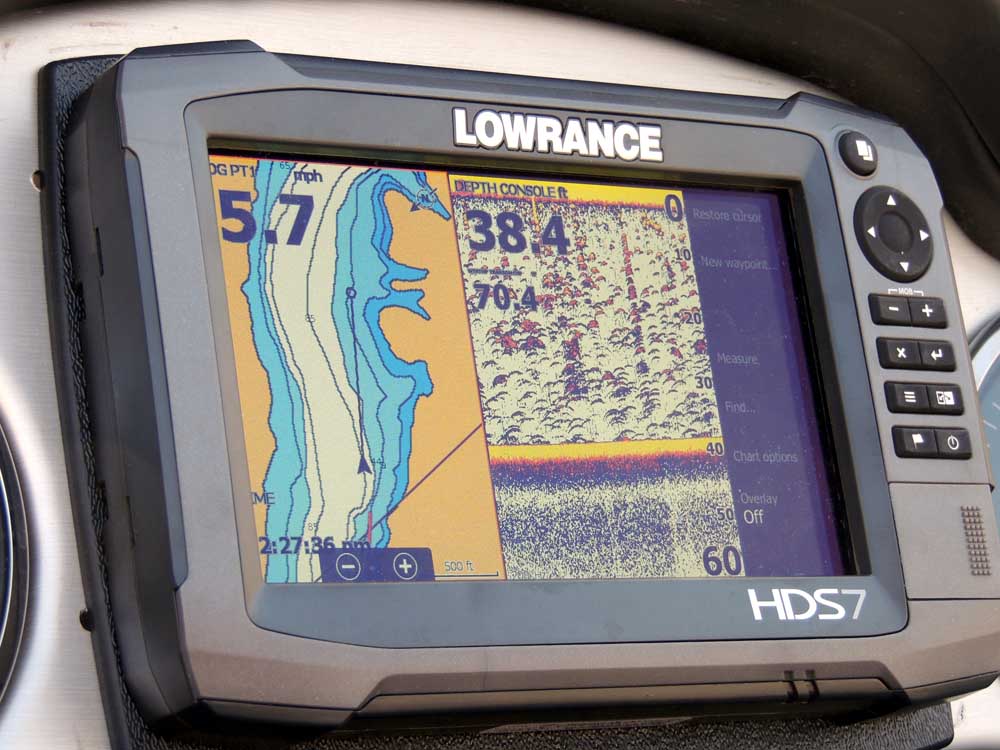Making sense out of sonar on the Columbia
Published 12:00 am Wednesday, September 21, 2016

- Gary Lewis / For The BulletinLarry Hutchens has worked with a Lowrance fish finder since the 1980s, but he has started a new business to help anglers get the most out of their marine electronics.
Boats were massed at the mouths of White Salmon, Klickitat and Deschutes rivers; trucks and trailers jammed the launches. While they swerved, sweated and swore, we left the madness behind and ran from our base at Peach Beach across from Biggs Junction up to Arlington where we put the boat in on a quiet launch.
All the attention was on the salmon fishery, but we were headed out for smallmouth bass.
Trending
Any day on the Columbia, an angler could put a trophy smallmouth in the boat. The trick is to sort through the little ones. In fact, an angler’s potential to catch the state record improves with every hour on the water. I know, I’ve had fish that big at the end of my line.
Larry Hutchens has worked with a Lowrance fish finder since the 1980s, but he has started a new business to help anglers get the most out of their marine electronics.
Doug Wilson was in the boat with us. The Seattle resident has made his living as a writer and photographer.
I started with a Rat-L-Trap while Wilson employed a TTI-Blakemore Swim-N-Runner and Hutchens cast a Yakima Bait Timber Tiger.
Hutchens cut the big motor quite a distance from shore, and I remembered there was a hump here, a spot where smallmouth bass gather to ambush baby shad headed downriver. I cast, let the lure drop to a five-count and started to reel. Immediately, I had a fish on then lost it. Moments later, I hooked another.
Hutchens found this spot quite a few years ago when he was exploring with his electronics.
Trending
“I like to drive around looking for structure and places that hold fish,” Hutchens said. “If I find a place with a lot of fish, I mark it so I can come back later.”
Personally, I like to drive around and get out of the wind. There were whitecaps on the Columbia, and we were tugging our hats down to keep them on our noggins when Hutchens decided we should seek shelter on the Oregon shore. We caught a few more bass there, and then the wind shifted to the northeast.
We blasted back to the launch, pulled out, drove west and launched at Le Page Park to fish the mouth of the John Day River. With the high canyon walls above us, we found calmer water and bass that were eager to bite. I switched to a Swim-N-Runner and bounced it along the bottom.
Hutchens had switched to fish-finding mode.
We motored up the river channel and Hutchens split his Lowrance HDS7 screen to three, sometimes four windows, and toggled between side scan, structure scan, chirp sonar, GPS with map chart and down scans.
Hutchens likens where we are with marine electronics to where we were in 1989 when personal computers were on the market and no one knew how to run them.
“There were no resources,” Hutchens said. “Then came networking, the internet and Wi-Fi. Now all these things are available for marine electronics. People that didn’t get on board when these things became available, they need help.”
The primary market for fishing electronics is the people, usually between age 40 and 70, who are interested in expanding their fishing knowledge. A lot of these people are salmon fishermen or kokanee fanatics, and they want to go for tuna out in the ocean.
“Kokanee are just baby tuna in terms of their behavior,” Hutchens said. “One of the best tools for the kokanee fisherman is side scan. It’s looking for tiny fish, individual targets.”
Often, the fisherman needs two screens. Salmon fishermen drive in the front and fish in the back, while bass anglers drive in the back and fish up front. Screens can and should be networked, so waypoints can be stored on both units. Networking can help save dollars when buying extra software, too.
“If I buy a $200 map card from Navionics, and I have both my units networked, I only have to buy one copy. When they are not networked, I have to buy two copies,” Hutchens said.
Idling up the John Day channel, Hutchens demonstrated side scan at work. Our depth averaged 40 feet while the scan searched for fish 100 feet to each side. Hutchens said in deep water, while searching for schools of kokanee or tuna, the scan would reach 250 yards out on each side. But there were a lot of fish below us, too many to ignore.
Hutchens cut the motor and threw his crankbait toward a sandbar. Reeling hard, the plug dove deep and then the rod bent over. The yellow flanks of a walleye flashed in the green depths, and Hutchens leaned over to pluck the beast from the water.
I’m guessing Hutchens marked that spot with a walleye waypoint. He’ll fish that spot again when the wind whips whitecaps on the big river.
— Gary Lewis is the host of Frontier Unlimited TV and author of Fishing Central Oregon, Fishing Mount Hood Country, Hunting Oregon and other titles. Contact Gary at www.GaryLewisOutdoors.com.







